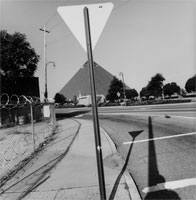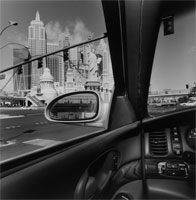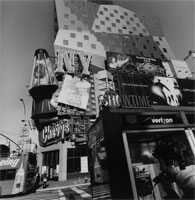Lee Friedlander
Sticks and Stones:Architectural America
|
Exhibition Dates: July 8 - Sept. 12, 2005
Reception for the Artist: Friday, July 15, 2005, 4-6 p.m. |
|
The Andrew Smith Gallery opens an exhibit of new photographs titled STICKS AND STONES: ARCHITECTURAL AMERICA by the American master LEE FRIEDLANDER on July 8, 2005. There will be a reception for the artist on Friday, July 15, 2005 from 4 to 6 p.m. Lee Friedlander is internationally regarded as one of America's most important photographers. A major retrospective survey of 600 of Lee Friedlander's photographs is concurrently on exhibit at the Museum of Modern Art in New York through August 2005.
In the early 1960s Lee Friedlander's silver print photographs offered a shockingly new aesthetic of an asymmetrical and fragmented United States. Lacking defined borders and layered with a disjointed profusion of architectural and advertising elements they were compared to the broken, improvisational rhythms of jazz. It has been said that Friedlander "upended the earnest humanism of postwar photography with his lively, irreverent glimpses of city streets and his tongue-in-cheek self portraits of the 1960s. The offhand wit and graphic verve of those early pictures have never disappeared, but since the early 1970s the photographer's mastery of craft, affection for tradition, and voracious curiosity have spawned a fluid stream of observation, ever more nimble and sensuous." Over the last fifty years Friedlander has continued to photograph what he calls the "American social landscape," recording the architecture of cities and towns with single-minded devotion and an unflinching eye for realism. Transcending mere documents, his photographs are the result of the artist's unique ability to structure scenes through the camera lens, echoing Garry Winogrand's remark, "I photograph to find out what something will look like photographed." Friedlander claims he could not have made the images in STICKS AND STONES when he was forty. They are the result of a lifelong familiarity with his subjects, and an ongoing exploration of the camera's unique way of visualizing the world. Using a square-format camera with no special features other than a wide-angle lens, Friedlander approaches his subjects directly, gathering and compressing multiple perspectives within the square frame. Working within the tradition of Eugene Atget, Walker Evans, Charles Sheeler, Garry Winogrand, and Robert Frank, Friedlander has returned again and again to photograph certain cities and towns whose streets, sidewalks, alleyways, avenues and back yards continue to intrigue him. Shaped and reshaped by their inhabitants for decades, these places are characterized by eccentricities and imperfections, and the glut of utilitarian features viewers tend to visually edit out -- telephone booths, chain link fences, advertising, phone poles, and street signs. Through Friedlander's vision Architectural America is a complex and sometimes humorous mixture of order and chaos, warmth and alienation, freedom and restraint, nature and commercialism. Photographs in the exhibit at Andrew Smith include:  Memphis, Tennessee, 2003 Memphis, Tennessee, 2003Titling the picture plane of the camera slightly off center Friedlander transforms our view of an ordinary urban scene into patterns of pure geometric design. Centered in the photograph two triangular shapes, one light and one dark, conjunct with each other end to end. The top triangle is, in fact, the back of a yield sign, while the bottom triangle is an enormous building in the distance. The camera lens equalizes the sizes of these vastly different objects. Roadway, sidewalk and fence line synthesize into a sweeping crescent below two flat triangles of sky.  Las Vegas, Nevada, 2002 Las Vegas, Nevada, 2002Friedlander frequently uses the device of multiple-perspectives in a single image. In this densely constructed photograph four different scenes occupy the same two-dimensional space and describe 180 degrees of actual space. On the left side of the photograph the car's window frames miniature replicas of the Statue of Liberty, Grant's Tomb, the Chrysler Building, and other architectural icons of the Las Vegas casino attraction, "New York-New York". The front window of the car frames a pedestrian walkway. The interior of the car forms another "picture" of the steering wheel, various gages and control panels. Finally, the rear window on the driver's side offers a smaller view of another pedestrian crosswalk.  Cody, Wyoming, 2000 Cody, Wyoming, 2000The side of a white clapboard hourse in this photograph recalls Charles Sheeler's interest in the precise geometric shapes found in barns and farm houses, as well as Walker Evans' straightforward, "truthful" depictions of vernacular architecture. The monolithic structure containing three rectangular windows fills Friedlander's photograph, with its pitched roof just touching the top edge of the print. A diagonal shaft of sunlight subdivides the uniform facade into triangles of light and shadow.  New York, New York, 2002 New York, New York, 2002In "New York, New York" the camera both recorded and distorted the view of a garish hodgepodge of giant billboards splashed across a post-modernist building resembling an abstract painting. Dwarfed by these titanic structures, a woman standing on a street corner appears bug-size. Close to the foreground a man talking on a phone seems nearly as large as the buildings.  Chicago, Illinois, 2003 Chicago, Illinois, 2003Shot close up a traffic light dominates this photograph like a monstrous totemic head sporting three eyelids. The composition, filled with a diminishing perspective of cars and skyscrapers, consists of vertical and horizontal lines, all dynamically tilted slightly off center.  New Mexico, 2001 New Mexico, 2001Telephone poles, signs, and street lights are scattered across a flat, sun drenched suburb. In this bland space Friedlander discovered an unusual mirroring effect. Sky and pavement, each of similar light values, mirror each other and extend the impression of the horizontal plane. The vertical dimension is elongated by telephone poles that appear twice their usual size due to their dark shadows cast on the pavement. In this cross shaped composition a squat fire hydrant and a stop sign take on the appearance of whimsical side kicks.  San Diego, California, 2002 San Diego, California, 2002Desolate, funereal, and optically baffling, "San Diego, California" recalls photographer Robert Franks' "sad poems" of America. The photograph is actually a straight shot of dumpsters in a dreary parking lot. In the near foreground below the dumpsters and wedged like a small grave, is a lush flower bed enclosed in a tiny white picket fence. What should appear as a unified image is split uncomfortably between visually and psychologically incongruous environments.  New Orleans, Louisiana, 1994 New Orleans, Louisiana, 1994Friedlander photographed his shadow cast onto a utility box in a city parking lot, recalling his ongoing interest in self-portraiture. In the past Friedlander has photographed his own shadow on the ground, or cast upon objects, and even on a passerby. By this method he obliquely refers to his role as the photographer taking the photograph. Perhaps he is also directing our attention to the camera as an independent mechanism that brings artist and world together. Lee Friedlander was born in Aberdeen, Washington, in 1934. Beginning in 1963 with an acclaimed one-man show at George Eastman House, he has had exhibitions at the Museum of Modern Art, New York; Corcoran Gallery, Washington D.C.; National Gallery of Victoria, Melbourne; Center for Creative Photography, Tucson; and the San Francisco Museum of Modern Art. He is the recipient of numerous awards and fellowships including a MacArthur Grant (1990) and the MacDowell Colony Award (1986). Friedlander's photographs have been widely exhibited and published. They have also been the subject of over two dozen books including Self-Portrait, Like A One-Eyed Cat, American Musicians and Sticks and Stones: Architectural America. Liz Kay |